The New Jersey Devils acquired a few new prospects via trade this season. With 2019-20 at a standstill, let’s look at the positive impact these additions have made on the overall quality of their prospect pool. This list of top 10 prospects is based on a simple metric has been used to rank the players.
Related: Devils Improved Prospect Pool Through Trades
Players were given a ranking based on a 1-10 scale in two categories: NHL Readiness and NHL Potential. NHL Readiness ranks how close a player is to playing in the NHL. NHL Potential ranks what kind of impact that player is likely to have at the next level. For the sake of this article, any player who no longer qualifies as an NHL rookie was not considered a prospect.
Honorable Mention: Nathan Bastian, Right Wing, 41st Overall, 2016
Bastian just misses the cut. His ceiling has capped out. He was drafted on the hope that he would become a James Van Riemsdyk-type player, but that hasn’t happened. However, he has shown he can get down and dirty and play in the difficult areas. With Wayne Simmonds gone, Bastian seems like a natural fit to be a grit/energy regular in the Devils’ lineup next season.
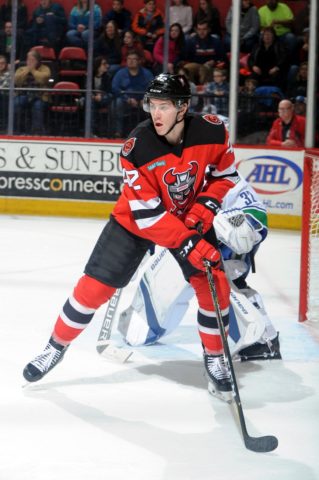
He has good size, excellent strength and is a great locker room personality. If he can cement himself as a player who can be counted on and can perform on special teams in the NHL, he might have a future with the franchise, in a depth role.
#10: Nikita Okhotyuk, Defense, 61st Overall, 2019
Okhotyuk’s season has been hampered by injury which really lowered his readiness score. Taking him 61st overall was a bit of an unheralded move by the Devils. He lacks the offensive upside that scouts are looking for in a modern NHL defender.
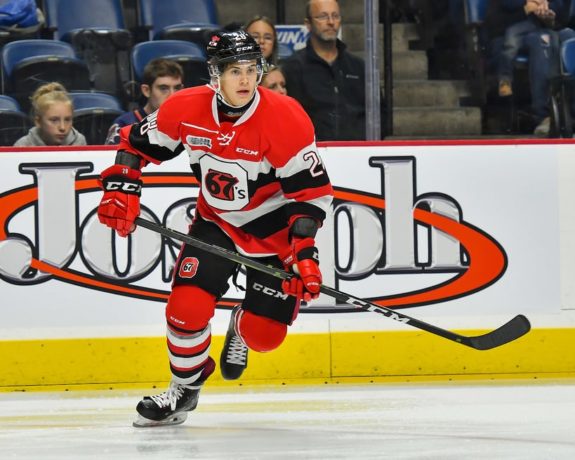
However, the other aspects of his game are top-notch. He’s a very difficult player to play against. He is strong positionally, has good hockey IQ, and solid lateral movement to go with his bone-crushing hits. He also has a powerful shot that he should use more often. He’s continued his development in one of the top defensive systems in the OHL with the Ottawa 67’s. He’ll turn 20 before Dec. 31, so he’ll qualify to play in the AHL next season. That’s probably where the Devils will put him.
#9: Gilles Senn: Goaltender, 129th Overall, 2017
Senn was 21 years old when he was drafted, so he’s in an age group where players stop being considered prospects. In his first North American professional season, Senn has been the water carrier for the Binghamton Devils. The solid, steady play from the 6-foot-5, Swiss native was a driving force behind Binghamton roaring into the playoff conversation before the AHL season was halted.
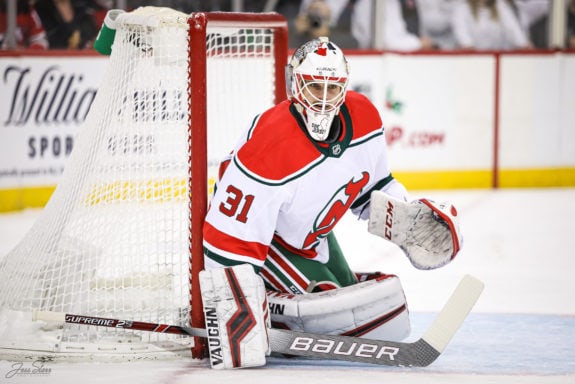
In his one NHL start of the season, Senn turned in an admirable (35 saves on 38 shots) losing effort against the Columbus Blue Jackets. His strong play in the AHL will give the Devils some flexibility regarding Cory Schneider. It seems that, if called upon, Senn could be the Devils’ backup goalie next season.
#8: Reilly Walsh, Defense, 81st Overall, 2017
It feels like Walsh has been on these lists since he was drafted in June of 2017. For three seasons he has been a consistent producer and key contributor for Harvard in one of the toughest NCAA conferences. He has been a key component of Harvard’s power play his entire tenure with the team. His bread and butter are his skating ability and offensive gifts.
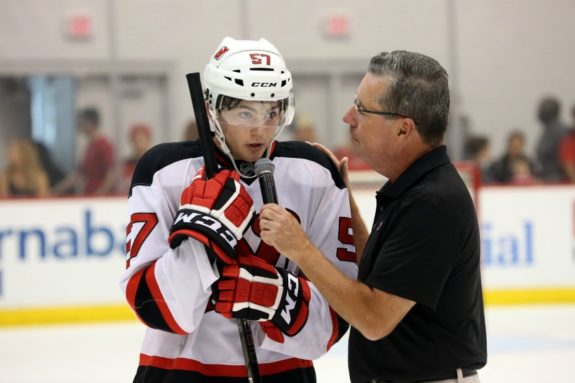
There are some question marks about whether or not he’ll be able to adapt his defensive game to the NHL level, but his wheels and hockey IQ in the offensive zone should be enough to make him a valuable asset to the Devils. With his third year at Harvard completed, and given the uncertainty of the Devils’ defensive depth, it wouldn’t be surprising if Walsh makes a push out of camp, but he probably needs at least one year in the AHL.
#7: Kevin Bahl, Defense, 55th Overall, 2018
Kevin Bahl was the key piece acquired in the Taylor Hall trade. He’s got the size that every hockey fan wants to see playing on their team’s defense. With that 6-foot-7 frame comes a long reach and a big body that punishes opponents along the wall and in open ice.
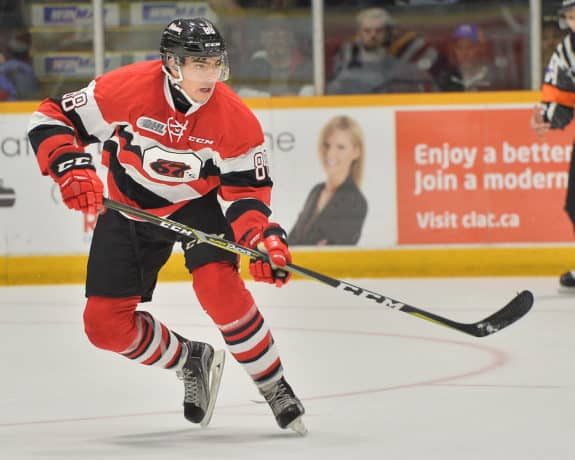
There’s a prevailing belief that big means slow-footed. That’s simply not the case with Bahl. In the OHL this season and while winning a gold medal with Team Canada at the World Junior Championships, he showed he would not be out-paced by his contemporaries. This bodes well for the Devils because high-quality, big, shut-down defenders are an endangered species in the NHL right now.
Related: Was Devils’ Return for Taylor Hall Enough?
Bahl’s combination of size and strength should help him make a push for the Devils lineup next season. The coaching staff will have to decide if they want to give him NHL playing time or if they’d prefer he continues his development elsewhere.
#6: Mikhail Maltsev, Center, 102nd Overall, 2016
Mikhail Maltsev seems to have flown under the radar since he was drafted. He had one exceptional highlight-reel moment during the preseason with the Devils where he deked and dunked on New York Rangers goalie Alexander Georgiev.
Since then, Maltsev has spent his first North American professional season in the AHL. His 21 points in 49 games are respectable for a first-year, 22- year-old, KHL import. Where he excels, is with his two-way game. He is a very smart, reliable, three-zone player. He’s also a relentless forechecker, a good back-checker and very hard to strip of the puck.
He’s learning how to effectively use his 6-foot-3, 220-pound frame on the smaller North American ice. Last season, he was used extensively as a shut-down center for SKA St. Petersburg in the KHL playoffs. Should the Devils decide not to retain some of their depth forwards from this season, expect to see Maltsev in a depth role on the NHL roster in 2020-21. However, at this juncture, the Devils seem likely to keep him in the AHL to see if he can develop a more consistent scoring touch.
#5: Tyce Thompson, Center/Wing, 96th Overall, 2019
The Devils knew something that everyone else didn’t when they took a 4th round flyer on overaged Tyce Thompson. He turned in a banger of a sophomore season at Providence where he finished 4th in the NCAA in points with 44 in 34 games. His 1.29 points per game rank 7th in the NCAA.
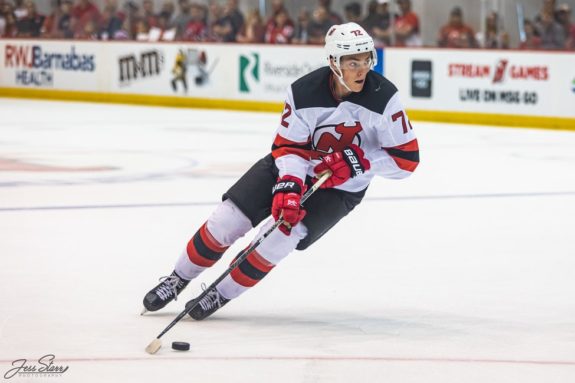
What should entice Devils fans about Thompson is his willingness to fire the puck on net with accuracy and poise. He always had excellent jam and a strong “compete level”, but this season he found his scoring touch. Being a dominant scoring force for a team in the Hockey East conference suggests that the next step in his development would be to earn professional minutes next season. Whether that’s in the NHL or AHL remains to be seen, but don’t count Thompson out. It wouldn’t be the first time he surprised his detractors.
#4: Nolan Foote: Left Wing, 27th Overall, 2019
Nolan Foote was acquired in the trade that sent Blake Coleman to the Tampa Bay Lightning, and he immediately earned a spot among the top prospects in the Devils’ system. Foote’s physical attributes are what scouts dream of. He’s 6-foot-4 with deceptive speed, an excellent compete level and brute strength. His greatest gift is his rocket of a shot, and he has shown time and again that he has a powerful, accurate shot that he’s not afraid to use.
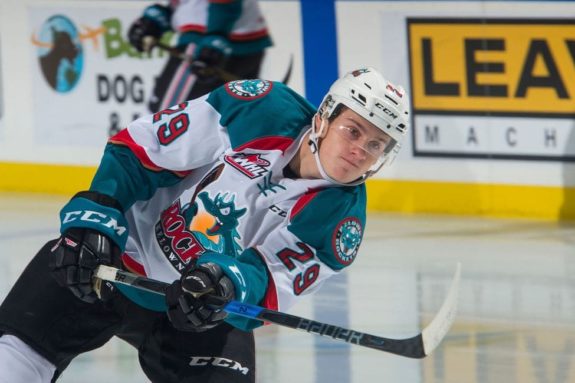
The Devils have been missing a player in their system who can generate quality shots in the cycle. In recent years, they’ve drafted a lot of forwards with good playmaking skills and the potential to make things happen off the rush. Foote is the kind of forward who finds a soft area while working in the cycle, gets loose and then fires a shot once he’s sent the puck.
Related: Trade Deadline: 3 Teams That Improved Their Prospect Pools
Paired with a stud play-making center, Foote projects to be an incredibly dangerous weapon. His three-zone play is underrated considering how well he played at the World Juniors for Team Canada. Foote has all the tools to make it at the next level. He will likely get a long look in the preseason, with a chance to play with both Jack Hughes and Nico Hischier to see if he’s able to build chemistry with either one. It would be surprising if he’s not in the NHL next season.
#3: Nick Merkley: Right Wing, 30th Overall, 2015
Nick Merkley was another piece acquired in the Taylor Hall trade. Injuries hindered his development during his first couple of years in Arizona’s system, but he seems to have taken advantage of his second chance with New Jersey. After obtaining no points through his first four games, he went on a tear, producing 18 points through his next 16 games. His production was enough to earn him a four-game call-up to the big club, where he scored his first NHL goal.
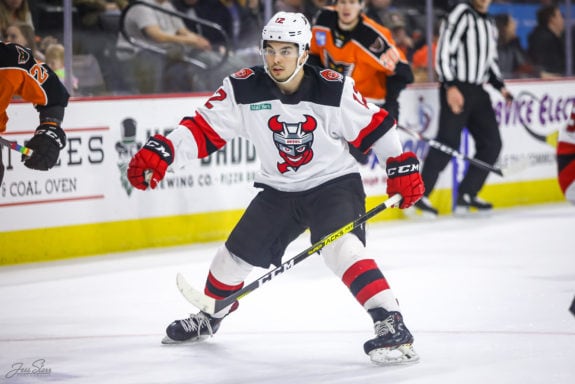
What Devils fans saw from Merkley is the embodiment of a player who is not particularly fleet of foot, but makes up for it with hockey IQ and raw determination. He is also fearless and plays with the heart of a lion, in spite of his 5-foot-10 frame. He has the grit to go to the dirty areas, but the on-ice smarts to exploit the soft areas.
Where the Devils will benefit most from his play is on the power play. Since his arrival in Binghamton, their power play has run through him on the left half-wall. He doesn’t always get the assist, but when Binghamton scores a power-play goal, it’s a pretty safe bet the play began with Merkley. He doesn’t project to be more than a middle-six forward at the NHL level, but he’s the type of player who could complement two more skilled players on a line. His usefulness on the power play, however, is something the Devils need. Expect him to be full-time next season.
#2: Janne Kuokkanen: Left Wing, 43rd Overall, 2016
This was a phenomenal pickup by interim general manager Tom Fitzgerald in return for Sami Vatanen at the trade deadline. Kuokkanen has been a good point-producing forward at every level he has played, but his best attribute is his puck retrieval skills in the offensive zone. If there is a contested, 50/50 puck in the offensive zone, Kuokkanen is going to get to it. He’s very similar to Jesper Bratt in this regard, but at 6-foot-1 he has the extra reach that Bratt lacks. His skating, play-making and scoring touch are all at the caliber of a future middle-six NHL forward.
The reason he didn’t crack the NHL sooner has to do with the Carolina Hurricanes’ loaded forward prospect pool. In 11 NHL games for Carolina and one for the Devils, he failed to find the scoresheet. His 126 points through 164 AHL games suggest that the trend won’t continue if he’s given time to build chemistry with his linemates. What’s also encouraging is that his point-per-game totals have trended up in every one of his AHL seasons. In his first season, he had 0.67 points per game, and that increased to 0.79 and 0.86 in subsequent seasons. It’s not a question of if he makes the big club, it’s where he’ll slot in and what kind of impact he’ll have as a rookie.
#1: Ty Smith: Defender: 17th Overall: 2018
After being one of the last cuts from 2018 training camp, fans almost expected Ty Smith to be a shoo-in, in 2019. It was disappointing when he wasn’t.
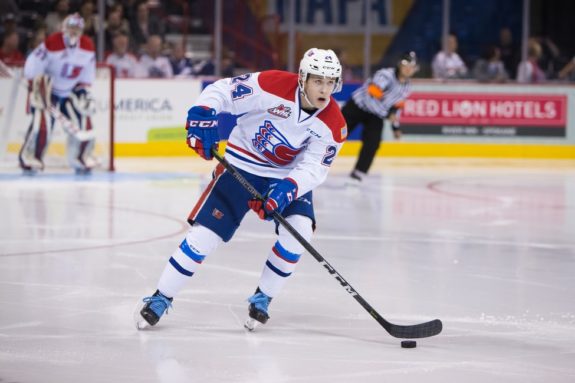
What Smith did, in the wake of disappointment, was go back to juniors and play dominant hockey. He captained the Spokane Chiefs for a second season, setting a new personal best in goals (19), and points per game (1.28). At the World Juniors, he was the lynchpin of a stalwart Team Canada defense that captured the gold medal.
Related: Devils Receive Fair Returns for Simmonds, Vatanen
The only thing left for Smith to do is turn pro. He might still be a year away from the NHL, but don’t let the disappointment in 2019 fool you. Smith is a future star for the Devils on defense.